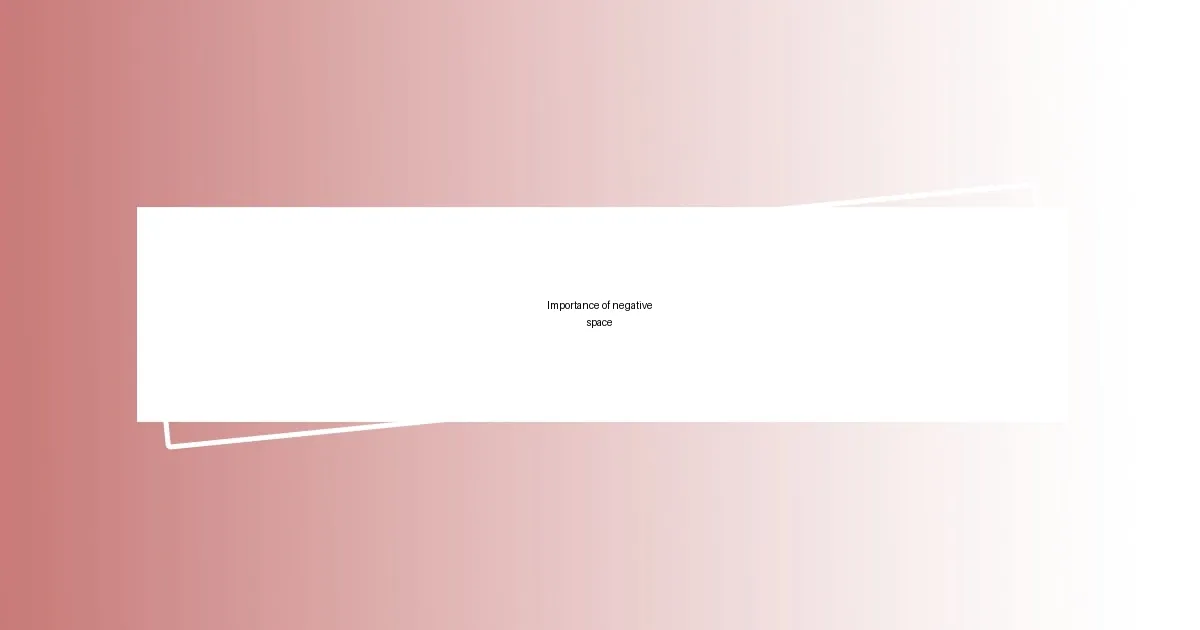Key takeaways:
- Space is integral to sculpture, influencing viewer perception and emotional experience.
- Negative space enhances visual balance, emotional engagement, and guides movement through the artwork.
- Material choice and texture evoke specific emotions, adding depth and character to sculptures.
- Techniques like sketching, maquettes, and triangulation are vital for refining balance and interaction within sculptural space.

Understanding space in sculpture
When I approach sculpture, the first thing that captivates me is how space is manipulated around the piece. It’s fascinating to think about how an artist considers not just the material they’re using, but also the surrounding environment. Have you ever walked around a sculpture and noticed how your perspective changes? It’s like a dance between the artwork and the space it occupies, and I find that incredibly inspiring.
There are moments when I’m working on a piece, and I step back to see how the space interacts with it. I remember one specific instance when I was crafting a large outdoor sculpture. I felt a real connection to the landscape that surrounded it, as if the natural elements were collaborating with my creation. It made me realize that the space isn’t just a backdrop; it’s an integral part of the art itself.
Understanding this relationship between sculpture and space enhances the emotional experience for the viewer. When I see a piece that resonates with its environment, I can’t help but feel drawn to it. It raises the question: how much of our perception of art is shaped by where it stands? This interplay truly deepens our connection to both the sculpture and the space it inhabits.

Importance of negative space
Negative space plays a foundational role in sculpture, serving as the silent partner in the artistic dialogue between form and environment. I remember a time when I created a piece that hinged on the voids around it; stepping back and seeing how those empty areas drew attention to the actual sculpture was a revelation. It was like finding clarity in chaos, where the lack of material suddenly became as important as the material itself.
The beauty of negative space is that it not only influences visual balance but also evokes emotional responses. During one exhibition, I saw viewers lost in contemplation as they absorbed the empty spaces around the pieces. The atmosphere changed – those quiet spaces allowed the audience to breathe with the artwork, prompting reflections that were as significant as the forms themselves. It’s in that reflective stillness that the sculpture truly comes to life.
Furthermore, negative space can create movement and rhythm within a piece, guiding the eye naturally through the composition. In my experience, when I intentionally design with these voids in mind, I notice a dynamic shift in how people engage with the work. They seem to effortlessly find their way around the sculpture, often commenting on how the space feels as if it’s inviting them in, fostering a conversation that extends beyond just the tangible forms.
| Aspect | Observation |
|---|---|
| Visual Balance | Negative space enhances the overall harmony of the artwork. |
| Emotional Engagement | It fosters a deeper connection with the viewer through reflective moments. |
| Guided Movement | Creates a natural flow, influencing how the audience navigates the piece. |

Techniques for balancing forms
The techniques for balancing forms in sculpture are often rooted in observation and experimentation. I remember a workshop where I played with different materials and weights, arranging them in various configurations. There’s something exhilarating about discovering how a slight shift can change the entire composition. For instance, a heavy base paired with lighter elements can create a sense of stability while allowing the forms to engage dynamically with their environment.
- Weight Distribution: Consider the relationship between heavier and lighter elements. Balancing these can create tension or serenity in a piece.
- Contrasting Shapes: Using geometric shapes alongside organic forms can enhance visual interest. I’ve noticed that the stark differences often draw the eye.
- Tilt and Angle: Slightly tilting a piece can inject energy into the composition. I’ve experimented with angles, which often create a sense of movement and interaction with the viewer.
- Layering: Superimposing layers or forms creates depth. I find that layering not just adds complexity but can evoke a powerful emotional response.
Sometimes, a breathtaking moment comes from simply stepping back and letting intuition guide my adjustments. There’s magic in the act of balancing forms, where intuition and craftsmanship intersect.

Choosing materials for harmony
Choosing the right materials for harmony in sculpture is an art in itself. I’ve often found that the texture of a material can influence not just the visual appeal, but the emotional vibe of the piece. For example, using smooth marble can evoke feelings of calm and purity, while rugged stone tends to provoke thoughts of strength and durability. Isn’t it fascinating how much emotion can be tied to something as foundational as material choice?
When I work with wood, I appreciate how its warmth invites a connection with viewers. I recall a time I crafted a piece from reclaimed wood, its rich history resonating through every groove and knot. People often commented on how the imperfections added character, making it more relatable. It leads me to wonder—how do our choices in materials speak to the stories we want to tell through our art?
I also believe in the power of color in materials. It’s almost like painting with physical form. During a recent project, I experimented with vibrant acrylics alongside natural textures, creating a striking contrast that drew in the audience. I witnessed firsthand how color can spark an emotional response, transforming a static piece into a dynamic conversation starter. Have you ever felt that shift in energy when vibrant colors are present? It’s truly transformative.

Composition strategies for sculptures
Composition strategies for sculptures
One powerful strategy I’ve embraced is the concept of negative space—the areas around and between the objects in my sculpture. I remember crafting an abstract piece where the gaps between forms became just as crucial as the forms themselves. It was a revelation to see how the viewer’s eye travels through the negative space, creating a dialogue within the piece. Isn’t it intriguing how an empty space can hold just as much significance as the material?
I also find that incorporating movement into my sculptures can captivate the audience. For instance, during a summer project, I introduced elements that swayed slightly in the wind. This interaction not only drew people in but made them part of the sculpture experience. Have you ever noticed how a piece that seems to ‘live’ in its environment feels more engaging? That subtle hint of kinetic energy can truly elevate a sculpture’s presence.
Another technique I’ve enjoyed is creating focal points with contrasting textures. While working on a recent project, I juxtaposed a sleek metal surface with rough, natural stone. This contrast not only highlighted each material but also told a story of harmony and conflict. I believe this strategy invites viewers to explore the relationships between forms more deeply. What emotions or thoughts arise for you when confronted with such contrasts? It’s a thrilling way to evoke a reaction.

Real-world examples of balance
One of my favorite examples of balance comes from my visit to a local sculpture park, where the artist cleverly utilized the surrounding landscape to enhance their work. I watched as a large stainless steel piece reflected sunlight, creating a stunning play of light and shadow across the grass. This interplay made me realize how harmony between a sculpture and its setting could evoke a serene ambiance, making me feel both grounded and uplifted.
I recall a particular exhibition featuring sculptures that balanced precariously on slender pedestals. At first glance, it seemed like a feat of engineering, but as I stood there, I felt the tension in the air—how the sculptures toyed with gravity yet maintained their poise. It sparked a thought: how does vulnerability within a sculpture create a stronger emotional connection with the audience? It’s almost poetic.
Another striking example is the use of tall, narrow sculptures that draw your eye upward, allowing you to appreciate both the form and the available space. In one memorable installation, the artist intentionally left ample room between pieces, making each tall figure stand proudly on its own. I found myself wondering if the space was a metaphor for human experience—how we often find strength in solitude while still being part of a larger narrative. Isn’t it extraordinary how space can influence our perception and understanding of art?

Tools for refining sculpture space
When refining the space around my sculptures, I often turn to tools like sketching and modeling software. I vividly remember a project where I used a 3D modeling app to visualize my sculpture in a particular environment. It allowed me to adjust the dimensions and positioning before physical creation, helping me ensure the piece would interact harmoniously with its surroundings. Have you ever found that digital tools can breathe new life into your artistic vision?
Another essential tool is actually something quite tactile: the use of maquettes. When I first ventured into sculpting, I created small-scale models to experiment with space and form. Those little mock-ups were crucial for understanding how my intended sculpture would occupy a larger area. I discovered that holding a physical representation in my hands, even at a fraction of the size, sparked fresh ideas and revealed unforeseen relationships between forms. Isn’t it fascinating how something small can translate into something monumental?
Triangulation is another technique that has significantly improved how I refine space in my sculptures. By focusing on balancing triangular shapes within my design, I create a sense of stability and flow that guides the viewer’s eye throughout the piece. I recall rearranging the layouts in my studio, using point markers to visually represent where each section would connect. This simple approach not only streamlined my design process but also deepened my understanding of balance within the piece—like a dance where every step is intentional. How do you find your own equilibrium when working with three-dimensional space?













